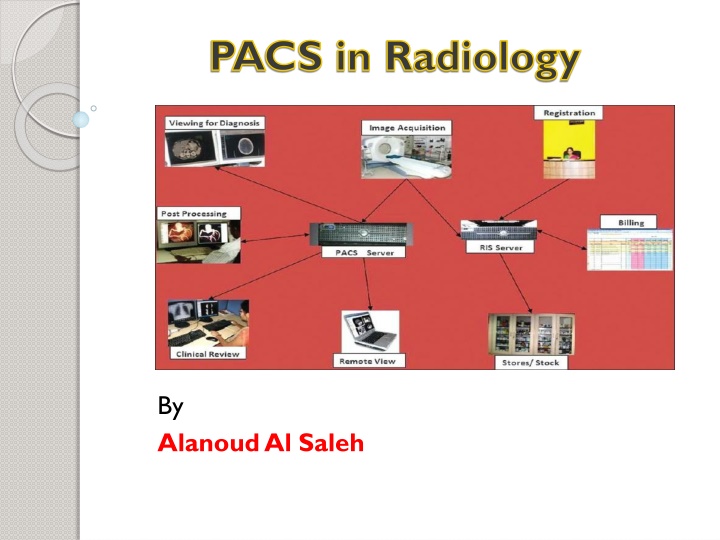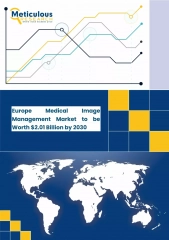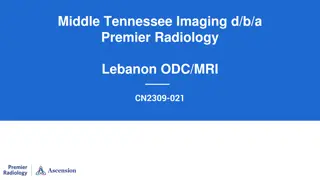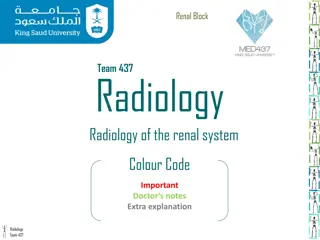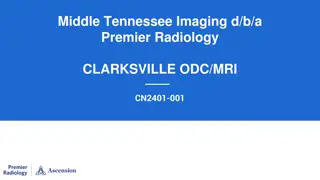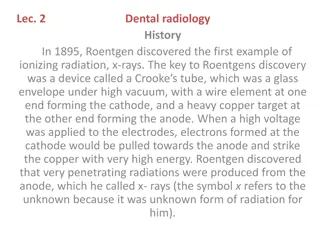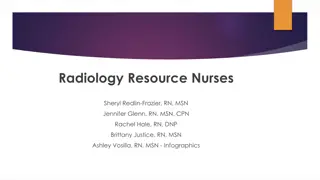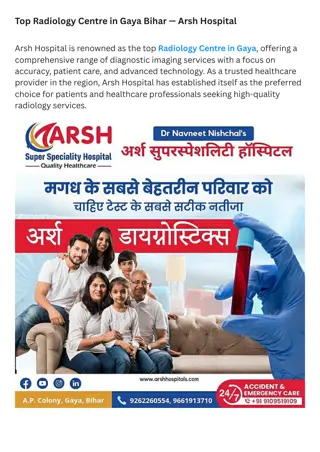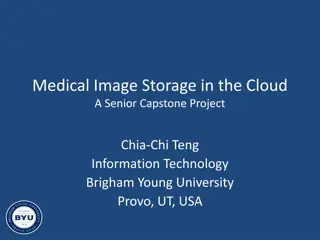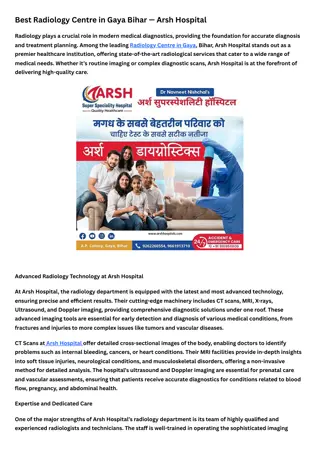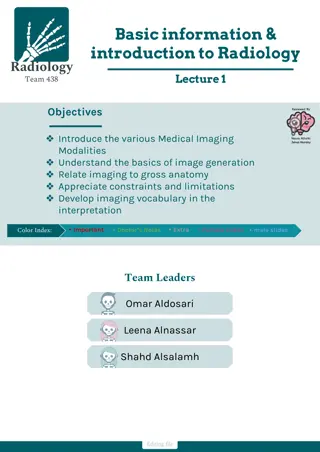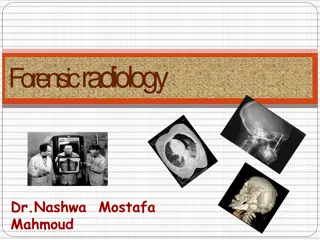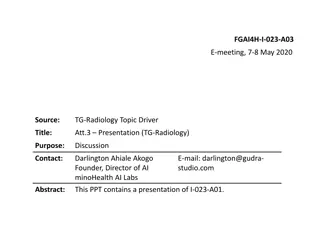PACS in Radiology
PACS (Picture Archiving and Communication System) plays a crucial role in modern radiology by enabling efficient storage, retrieval, and sharing of patient images digitally. It interfaces with hospital information systems (HIS) and radiology information systems (RIS) to streamline data flow and enhance patient care. PACS components include image acquisition devices, data management systems, storage devices, transmission networks, and image display stations. The purpose of PACS is to eliminate the limitations of film-based systems, providing instant access to images for improved diagnostic efficiency. Additionally, PACS image backup is essential for data preservation and continuity of care in case of image loss. Overall, PACS applications facilitate faster delivery of medical images, reliable image quality, and flexible viewing capabilities for healthcare professionals.
Download Presentation

Please find below an Image/Link to download the presentation.
The content on the website is provided AS IS for your information and personal use only. It may not be sold, licensed, or shared on other websites without obtaining consent from the author.If you encounter any issues during the download, it is possible that the publisher has removed the file from their server.
You are allowed to download the files provided on this website for personal or commercial use, subject to the condition that they are used lawfully. All files are the property of their respective owners.
The content on the website is provided AS IS for your information and personal use only. It may not be sold, licensed, or shared on other websites without obtaining consent from the author.
E N D
Presentation Transcript
PACS in Radiology By Alanoud Al Saleh
PACS and HIS&RIS All PACS, whether they span the entire enterprise or a localized within a department, should also interface with existing hospital information systems: Hospital information system (HIS) and Radiology Information System (RIS). There are several data flowing into PACS as inputs for next procedures and back to HIS as results corresponding inputs.
Typical Hospital IT Systems Interactions among hospital IT systems including modalities, picture archiving and communications system (PACS), radiology information system (RIS), hospital information system (HIS), and automation systems
PACS In Radiology Modern radiology equipment and modalities feed patient images directly to the PACS in digital form.
PACS image backup PACS image backup is a critical, but sometimes overlooked, part of the PACS Architecture Hospitals requires that backup copies of patient images be made in case of image loss from the PACS. There are several methods of backing up the images, but they typically involve automatically sending copies of the images to a separate computer for storage, preferably off-site.
What is the Purpose of PACS? PACS resolves many of the problems that were associated with film. Film could only be available in one place at a time and would frequently result in delayed patient care if it was not immediately available to the referring physician. With PACS, patient studies can be viewed from any computer at any of our facilities or from a referring physician s office. PACS also allows the radiologists to read studies performed at any of our facilities, from any of our facilities, making them much more efficient and greatly reducing the turn around time for report dictation.
PACS components : PACS includes several subsystems and components: 1. image acquisition devices 2. data management system 3. data storage devices 4. transmission network 5. image display stations 6. devices to produce hand-copy images.
PACS Applications 1-In Digital imaging which will allows: Faster delivery of medical images. Ability to report whenever you have free time. Reliable quality of images. Unlike film, there will never be any black spots on images due to bad light Flexible viewing with the ability to manipulate images on screen which allows for better analysis . Instant access to historic images and patient records, which enables the comparison of patient images (old and new) and thus the measuring of the effectiveness of their treatment or the development of their condition . Better collaboration, as PACS can be viewed from multiple terminals and locations at the same time . improved learning and training chances, both for trainee radiologists as they develop their skills and for existing radiologists as there is more chances to collaborate with colleagues and share learning and experience .
PACS Applications 2-PACS Applications in Radiology Imaging Radiographers can very quickly determine the quality of the image taken. As a result of electronic requesting, radiographers have all the necessary information available to them in a digitalised format. Information only needs to be entered into the system once. Radiographers experience lower radiation doses, as PACS reduces the need for repeat examinations . The ability to manipulate images once they are taken means that radiographers can zoom in on areas of interest to ensure adequate information has been captured. PACS contributes to a better working environment, as the lack of film processing will result in a quieter and chemical free workspace.
PACS Applications 3-PACS IN Non-radiology Non-radiology consultants will be affected by PACS, as this system contributes to the following: Fewer wasted appointments and postponed procedures because of non-availability of patient images Instant access to patient images, regardless of location Better collaboration and an increase in consultation between radiologists and clinicians Experience shows patients better informed when they can see their images on screen, this can lead to better quality consultations for both the patient and the consultant For hospital managers PACS frees up valuable space within a hospital as storage rooms will no longer be needed for films. Administrative staff, responsible for image retrieval and filing, are be freed up to undertake more productive tasks. Patients are processed more quickly with fewer delays. Cost savings are made as film and processing chemicals are no longer needed.
PACS Applications 4-PACS for Patients The benefits of PACS for patients include: not having to carry packets of film around the hospital and between sites. less waiting to receive results a speedier move to the next point of treatment . fewer appointments wasted and operations postponed because of non-availability of images as a result of lost or poor quality images less re-testing and, therefore, lower radiation dosage quicker discharge from hospital and better care planning resulting from easier access to images and test results .
PACS Challenges PACS have been in existence for several years and have become an integral part of the infrastructure of radiology and imaging departments across the world. PACS is a key workflow tool in the functioning of radiology departments worldwide, today, and its utilization is rapidly growing. The key challenges in PACS implementation are related to vendor and feature selection, integration with the existing HIS, user training, maintenance and scalability to meet increasing demands. Additionally, the networking requirements that PACS imposes on hospital networks are not insignificant.
Conclusions The practice of radiology is a complex system that includes generation of images with multiple modalities, image display, image interpretation and reporting, and image file management. Organizational systems that enable efficient functioning in small departments often fail as departments grow larger. The development of systems to meet increasingly complex needs will be challenging, the promise of a PACS is its ability to improve operational efficiency while maintaining on improving high diagnostic ability.
